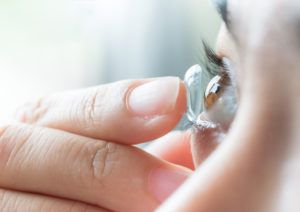Why it’s important to dispose of contact lenses the right way

Part of being a responsible resident or homeowner is knowing how to look after your drainage system, and how to avoid causing potentially expensive blockages in the pipes by flushing items down the drains that don’t belong there.
Some people will already be aware of the kind of problems that can be caused by fat, oil and grease (FOG), or food waste and wet wipes, ending up in the drains – but many overlook the risk posed when disposable contact lenses are flushed down the toilet.
Not only can this habit cause problems for domestic drains and public sewers alike, but it can also contribute to wider environmental issues in a way that most conscientious homeowners will be keen to avoid.
With this in mind, contact lens users should make themselves aware of what happens when contact lenses are disposed of improperly, and take the time to learn how best to do so in a responsible manner.
How do flushed contact lenses affect the drainage system?
Most people understand that contact lenses probably shouldn’t be put down the drain, but that doesn’t mean a lot of people don’t do it anyway.
A recent US study from Arizona State University estimated that between 15% and 20% of American contact lens wearers flush their used lenses down the sink or toilet, resulting in two to three billion lenses being disposed of this way each year in the US – the equivalent of 20 to 23 metric tons.
Contact lenses are generally made up of a mixture of silicones, fluoropolymers and acrylic glass – all kinds of plastic that do not easily break down over time. As such, they can clump together with other erroneously flushed items and substances – including FOG, wet wipes, plastic bags, nappies, sanitary towels and condoms – to form impenetrable blockages in the drains.
While contact lenses themselves only make up a small part of this problem, the knock-on effects can be significant. A blocked drain in the home can generate problems such as foul odours to domestic flooding, while the accumulation of foreign objects in public sewers can create giant fatbergs that block entire passageways, requiring expensive excavation work to remove.
You can find out more about fatbergs here, or read our advice on what you can and can’t put down the drain to learn more about how important it is to protect your drains from the kind of plastics commonly found in contact lenses.
How do flushed contact lenses affect the environment?
 Because the plastic content of these lenses cannot be easily broken down, they often make it all the way through the drains and into the ocean, where the small plastic particles and microplastics are mistaken for food by aquatic life, endangering their health. The plastics found in contact lenses are denser than water, meaning they are able to sink deep down and cause harm even to the bottom-feeders found on the seafloor.
Because the plastic content of these lenses cannot be easily broken down, they often make it all the way through the drains and into the ocean, where the small plastic particles and microplastics are mistaken for food by aquatic life, endangering their health. The plastics found in contact lenses are denser than water, meaning they are able to sink deep down and cause harm even to the bottom-feeders found on the seafloor.
What’s more, plastic particles derived from contact lenses can also get into the sewage sludge created as part of the wastewater treatment process, a substance that is often taken to landfill or used in fertilisers. This means the plastic content can end up being carried via rainwater into sources of drinking water, or into agricultural soil – creating a potential risk to human health.
How should contact lenses be disposed of?
More and more people are starting to realise the need to combat this kind of plastic pollution at all levels, and making sure used contact lenses are disposed of the right way is an important part of that.
Throwing old lenses in the bin keeps them out of the water system and avoids many of the problems associated with flushing them down the drain, but the best and most environmentally-friendly disposal method is recycling. In the past, their small size meant it was difficult to find an easy way of recycling contact lenses, but fortunately this is beginning to change.
Early in 2019, the first free contact lens recycling scheme in the UK was launched, giving wearers the choice of disposing of their old lenses at public drop-off points or having them collected. Established by Johnson & Johnson and offered through Boots Opticians and several independent stores, the scheme also recycles the blister and foil packaging in which lenses are provided, and will allow recycling firm TerraCycle to transform the old plastic into products such as outdoor furniture or plastic lumber.
It is hoped that initiatives of this kind, along with the growing awareness of plastic pollution problems in the drains and oceans, will help to encourage people to stop flushing away their contact lenses once and for all.







